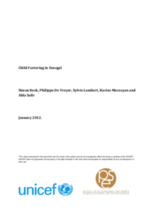In Sub-Saharan Africa, child fostering (confiage) is a common practice whereby children are temporarily sent by their parents to live with a host family. In Senegal, nearly 10% of the children are currently fostered and 32% of the households either send or receive foster children. The widespread nature of this tradition calls for a better understanding of its motivation and its impact.
Child fostering has been viewed as a tradition with potentially negative outcomes for children. Using data from a nationally representative household survey conducted in 2006-2007, the survey Pauvreté et Structure Familiale, this study aims at shedding light on the practice of fostering in three ways. First, the study examines the characteristics of households and individuals involved in fostering to better understand the motivation to foster. Second, the study examines the impact of fostering on host households and on sending households. Lastly, the study examines the impact of fostering on the foster child. The paper examines three child outcomes: ever attending school, ever working, and completing more than 28 hours of domestic work per week.
A large proportion of fostered children were found to be in the care of their grandparents (25%), with almost equal numbers fostered with uncles and aunts (22%). Access to education was a major motivation for fostering a child, particularly boys, but girls were more likely to be fostered to respond to household demands for domestic work. Interestingly, the study also noted that almost 20% of foster children were fostered due to parental problems (sickness, death or divorce) and that the probability that at least one parent migrated abroad was much higher for foster children than for the general population. In particular, among children whose mother migrated, 50% were fostered, compared to 6.3% of foster children whose mother lived in Senegal.Foster boys seemed to be in general more educated than their biological siblings and were sent to households who on average had a higher preference for education than non-host households. Foster girls, on the other hand, seemed to be more often sent to household where children undertake more domestic work. Although girls who are fostered were found to be neither more nor less likely to go to school than other girls, they were found to be at a disadvantage compared to girls in the host family when it came to education.
In both cases, however, the study found that that foster children were in general treated on a fair basis relative to their host siblings: boys went to school as much as other boys in host households and foster girls did not have heavier workload than girls in their host households. The authors concluded that for both boys and girls, fostering tended to protect their access to education relative to their biological siblings.
The study did not uncover any evidence pointing to particularly negative outcomes for fostered children, be it compared to children in the households hosting them or in the households they left. As a result, the authors recommend focusing policies on targeting households that may need a lot of domestic work or broader policies to at least ensure that domestic work does not come at the expense of schooling that will also benefit fostered children.
©UNICEF, Paris School of Economics

